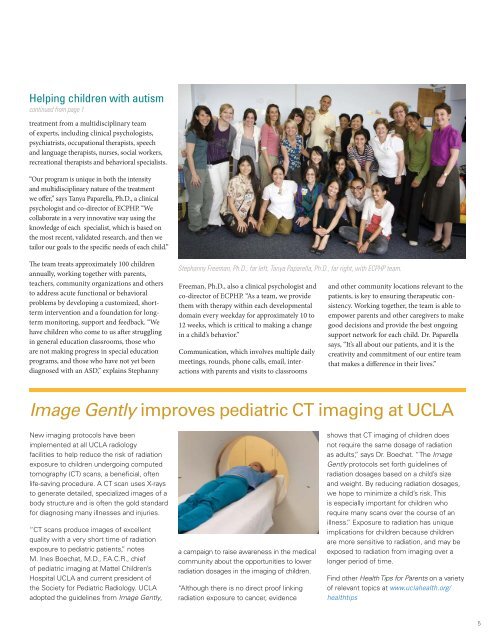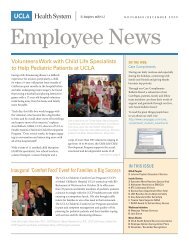continued from page 1 - Electronic Town Hall - UCLA
continued from page 1 - Electronic Town Hall - UCLA
continued from page 1 - Electronic Town Hall - UCLA
You also want an ePaper? Increase the reach of your titles
YUMPU automatically turns print PDFs into web optimized ePapers that Google loves.
Helping children with autism<br />
<strong>continued</strong> <strong>from</strong> <strong>page</strong> 1<br />
treatment <strong>from</strong> a multidisciplinary team<br />
of experts, including clinical psychologists,<br />
psychiatrists, occupational therapists, speech<br />
and language therapists, nurses, social workers,<br />
recreational therapists and behavioral specialists.<br />
“Our program is unique in both the intensity<br />
and multidisciplinary nature of the treatment<br />
we off er,” says Tanya Paparella, Ph.D., a clinical<br />
psychologist and co-director of ECPHP. “We<br />
collaborate in a very innovative way using the<br />
knowledge of each specialist, which is based on<br />
the most recent, validated research, and then we<br />
tailor our goals to the specifi c needs of each child.”<br />
Th e team treats approximately 100 children<br />
annually, working together with parents,<br />
teachers, community organizations and others<br />
to address acute functional or behavioral<br />
problems by developing a customized, shortterm<br />
intervention and a foundation for longterm<br />
monitoring, support and feedback. “We<br />
have children who come to us aft er struggling<br />
in general education classrooms, those who<br />
are not making progress in special education<br />
programs, and those who have not yet been<br />
diagnosed with an ASD,” explains Stephanny<br />
Image Gently improves pediatric CT imaging at <strong>UCLA</strong><br />
New imaging protocols have been<br />
implemented at all <strong>UCLA</strong> radiology<br />
facilities to help reduce the risk of radiation<br />
exposure to children undergoing computed<br />
tomography (CT) scans, a benefi cial, often<br />
life-saving procedure. A CT scan uses X-rays<br />
to generate detailed, specialized images of a<br />
body structure and is often the gold standard<br />
for diagnosing many illnesses and injuries.<br />
“CT scans produce images of excellent<br />
quality with a very short time of radiation<br />
exposure to pediatric patients,” notes<br />
M. Ines Boechat, M.D., F.A.C.R., chief<br />
of pediatric imaging at Mattel Children’s<br />
Hospital <strong>UCLA</strong> and current president of<br />
the Society for Pediatric Radiology. <strong>UCLA</strong><br />
adopted the guidelines <strong>from</strong> Image Gently,<br />
Stephanny Freeman, Ph.D., far left, Tanya Paparella, Ph.D., far right, with ECPHP team.<br />
Freeman, Ph.D., also a clinical psychologist and<br />
co-director of ECPHP. “As a team, we provide<br />
them with therapy within each developmental<br />
domain every weekday for approximately 10 to<br />
12 weeks, which is critical to making a change<br />
in a child’s behavior.”<br />
Communication, which involves multiple daily<br />
meetings, rounds, phone calls, email, interactions<br />
with parents and visits to classrooms<br />
a campaign to raise awareness in the medical<br />
community about the opportunities to lower<br />
radiation dosages in the imaging of children.<br />
“Although there is no direct proof linking<br />
radiation exposure to cancer, evidence<br />
and other community locations relevant to the<br />
patients, is key to ensuring therapeutic consistency.<br />
Working together, the team is able to<br />
empower parents and other caregivers to make<br />
good decisions and provide the best ongoing<br />
support network for each child. Dr. Paparella<br />
says, “It’s all about our patients, and it is the<br />
creativity and commitment of our entire team<br />
that makes a diff erence in their lives.”<br />
shows that CT imaging of children does<br />
not require the same dosage of radiation<br />
as adults,” says Dr. Boechat. “The Image<br />
Gently protocols set forth guidelines of<br />
radiation dosages based on a child’s size<br />
and weight. By reducing radiation dosages,<br />
we hope to minimize a child’s risk. This<br />
is especially important for children who<br />
require many scans over the course of an<br />
illness.” Exposure to radiation has unique<br />
implications for children because children<br />
are more sensitive to radiation, and may be<br />
exposed to radiation <strong>from</strong> imaging over a<br />
longer period of time.<br />
Find other Health Tips for Parents on a variety<br />
of relevant topics at www.uclahealth.org/<br />
healthtips<br />
5









